The rules of clinical acupoint selection and combination for Alzheimer’s disease based on data mining
Chao-Chao Yu#,1, Li Wang#,1, Li-Hong Kong*,2,3, Feng Shen*,2,3, Chao-Yang Ma 4, Yan-Jun Du2,3 , Hua Zhou2,3 and Pei-Yan Meng
(1 Hubei University of Chinese Medicine, Wuhan ,Hubei 430061, China;2 Department of Acupuncture and Moxibustion, College of Acupuncture and Orthopedics, Hubei University of Chinese Medicine, Wuhan ,Hubei 430061, China;3 Hubei Provincial Collaborative Innovation Center of Preventive Treatment by Acupuncture and Moxibustion,Wuhan,Hubei 430061,China;4 Department of Rehabilitation,Wuhan Central Hospital Affiliated to Tongji Medical College, Huazhong University of Science and Technology,No.26 Shengli Street, Wuhan ,Hubei 430014, China)
Abtract:Background: The aim of the present study was to investigate the rules of clinical acupoints selection and combination for Alzheimer’s disease(AD) by using data mining technology. Method: The clinical literature regarding acupuncture and moxibustion for AD was searched and collected from databases including Chinese Biomedical Medicine, China National Knowledge Infrastructure , Wanfang Database and PubMed. The database of acupuncture and moxibustion prescriptions for AD was established by using Excel software so as to conduct the descriptive analysis, association rule analysis on the data. Results: Baihui(GV 20), Sishencong(EX-HN1), Shenmen(HT7), Zusanli(ST36), Neiguan(PC6),et al.were of higher frequency in the treatment of AD with acupnucture and moxibustion.Most acupoints were selected from the Governor Vessel .The commonly used acupoints were located on the head, face, neck and lower limbs. The combination of the local acupoints with the distal ones was predominated. The crossing points among the specific points presented the advantage in the treatment. The association rule analysis indicated that the correlation among Fengchi(GB20)-GV20 was the strongest ,followed by combinations of Dazhui(GV14)-GV20,Shenshu(BL23)-GV20 and PC6-GV20 and indicated the common rules of the clinical acupoint selection and combination for AD. Conclusion: All of these results provide a reference for acupoints selection and combination for AD in clinical acupuncture practice.
Key words: Acuppoint selection and combination; Clinical application; Alzheimer’s disease;Data mining method
1.Introduction
Alzheimer’s disease(AD), the most prevalent cause of dementia, is characterized as a chronic,progressive neurodegenerative, severe and incurable disorder.AD is associated with
memory loss and cognition impairment accompanied by abnormal behavior and changed personality. The pathological features associated with the cognitive dysfunction are neurofibrillary tangles (NFTs) and senile plaques(SP), combined with neuron loss mainly in the hippocampus and important cortical and subcortical brain regions.1It is estimated that nearly 40 million people mostly older than 60 years have dementia worldwide, and this figure is projected to reach over 115 million by 2050 ,and making it one of the most threat to elderly health and presenting one of the biggest healthcare issues.2 Though the situation is severe, there is no effective therapy capable of alleviating symptoms or slowing down disease progression .3
Acupuncture, which is an important therapy method in Chinese medicine, has attracted growing attention for its complementary and alternative role in alleviating symptoms of some diseases safely and effectively. And recently it has been proved safe and effective in several diseases, including urinary leakage among women with stress urinary incontinence,4chronic severe functional constipation,5and migraine.6It has also indicted that acupuncture can ameliorate cognitive impairment and improve memory in AD patients.7Animal studies has found that the therapeutic effects of acupuncture may be achieved via multiple pathways, including clearing Aβprotein deposition,8 inhibiting tau protein hyperphosphorylation,9prompting neural transimission,10reducing oxidative stress.11The acupoints selection and combination play a critical role in impacting the therapeutic effects of acupuncture. However, determining the most effective acupoints selection and combination for AD still remains to be elucidated. Insufficient or improper acupoints selection and combination may contribute to a limited clinical therapeutic effects and the application of acupuncture for AD.
In recent years ,data mining method has been used to discover potential acupoints and Chinese herbs for improving the therapeutic effects of disease.Clinical trial has demonstrated that the dominant acupoints of Shaoyang Meredian ,which was based on the data mining results,were effective in alleviating pain symptoms and reducing migraine recurrence for a long time.6Also,acupuncture on ST36 of the Stomach Meridian was more effective than acupoints of the Gallbladder Meridian in alleviating functional dyspepsia.12These results may provide evidence that data mining method can be a promising and useful method to determine the rules of acupoints selection and combination for treating diseases.
To shed some light on the selection of acupoints and acupoint combinations for AD in clinical trials and animal research,we carried out a data mining analysis to discover acupoints and acupoint combinations that may have potential to treat AD though which we hopefully provide relatively evidence-based guidelines in the application of acupoints for AD.
2. Methods
2.1Search Methods.
Chinese Biomedicine Database(http://www.sinomed.ac.cn/),China National Knowledge Infrastructure(http://www.cnki.net/),Wanfang Database(http://www.wanfangdata.com.cn/), and PubMed (http://www.pubmed.com/) were searched for published literature on acupuncture therapy for AD from 1978 to August 2017.The search strategy combined the following keywords (1) “acupuncture”or “electroacupuncture” or “hand acupuncture”or“moxibustion” or “acupoint”; and (2) “Alzheimer’s disease” or “Alzheimer’s”or “AD”or “dementia”.Modern literature on acupuncture and moxibustion therapy for Alzheimer’s disease were included. Language was restricted to Chinese and English .
2. 2 Review Process.
(1)Types of Studies.
All clinical trials evaluating the effect of acupuncture and/or moxibustion, with or without methods of randomization and/or control were included. Case reports, experts’ experience, reviews, animal studies, systematic reviews, and meta-analysis were excluded.
(2) Types of Participants.
Clinical trials involving participants diagnosed with Alzheimer’s disease were included. Exclusion criteria included trials evaluating the therapeutic effect of acupuncture for cognitive impairment caused by other factors (e.g., vascular dementia, dementia with Lewy bodies, frontotemporal dementia, or other mental and emotional disorders (such as schizophrenia and depression)).
(3)Types of Intervention.
Inclusion criterias were as follows.The treatments for AD had to involve needle insertion and/or moxibustion at either traditional meridian acupoints or extraordinary acupoints. Acupuncture and/or moxibustion was either used alone or in addition to other interventions (e.g., Chinese herbs,western drug,diet,music and exercise therapy). Trials investigating and/or comparing different acupoints prescriptions or different manipulation methods of acupuncture or moxibustion for AD were also included. Trials investigating the modern methods of stimulating acupoints without needle insertion (e.g., laser stimulation or transcutaneous electrical stimulation)were excluded. Trials of microacupuncture systems were also excluded, since the theory of microacupuncture is not related to traditional acupoints. Trials evaluating stimulating trigger points for AD were excluded since the theory of trigger points is not related to traditional Chinese acupuncture theory.
2.3. Data Collection.
Two reviewers independently screened the records retrieved from the literature searches. Information about titles, interventions, and main acupoints was extracted using the self-established Excel sheets. All potentially relevant articles were investigated as full text in English or Chinese. Any discrepancies were resolved by consensus or consultation with another reviewer (Li-Hong Kong).The final version was included and used in case of duplicate publications.
2.4. Data Extraction.
The frequencies of acupoints, meridians, acupoints distribution on different body parts and acupoints attribute were extracted and analyzed .Description about acupoints and meridians were standardized according to the WHO Standard Acupuncture Point Locations in the Western Pacific Region.13
2.5.Data Processing.
Information about acupoints selection and combination can be obtained via calculating the acupoints frequency, support degree, confidence and lift based on the data mining algorithm.14 Support degree is an index to measure the probability that events X and Y occur simultaneously under specific conditions. The algorithm is as follow: Support(X→Y) = P(X,Y) /P(I)=P(X∩Y)/P(I)=num(X∩Y)/num(I). I represents the entire dataset, “num( )”represents the frequency or times of specific or defined dataset. Support degree is used to measure the statistical significance of association rules. Confidence is an index to measure the probability that the event Y occurs under the condition that event X prior occurs. The algorithm is as follow: Confidence(X→Y)=P(Y|X) = P(X,Y) / P(X) = P(X∩Y) / P(X). Lift displays the ratio of confidence for the rule to the prior probability of having the consequent. The algorithm is as follow: Lift(X→Y )= P(Y|X) / P(Y) .In general, association rules are only useful when the support degree and confidence level meet the minimum requirements.
3. Results
3.1. Study Selection.
Our initial search identified and screened 1923 articles.400 duplicates were removed. A total of 1432 articles were excluded based on the exclusion criterias. The remaining 91 records were retrieved for more detailed evaluation and 91 acupoints prescriptions were included in our data mining analysis .The selection process is available in Figure 1.
Figure 1: Flow diagram of data mining process.

3.2. Descriptive Analysis
(1)Analysis of Acupoints Frequency.
Acupoints frequency was analyzed based on the acquired 91 acupoint prescriptions.60 acupoints were involved in the treatmen of AD among which there were 58 meridian-acupoints and 2 extraordinary acupoints and they were recorded for total 498 times in modern clinical literature regarding acupuncture and moxibustion for AD.The top 15 acupoints used frequently were GV20,EX-HN1,HT7,ST36,PC6,GB20,KI3,GV14,BL23,SP6,GV24,ST40,GB39,GV26 and LR3in turn. Detailed information can be checked in Figure 2(A).
(2)Analysis of Meridian Frequency.
There were 58 meridian-acupoints which were recorded 458 times in the 91 acupoint prescriptions. Their distribution of meridian can be checked in Table 1 and Figure 2(B).13 meridians were involved. The most frequently used meridian was the Governor Meridian (129 times)followed by the Gallbladder Meridian of Foot Shaoyang(54) the Stomach Meridian of Foot Yangming(50) and Bladder Meridian of Foot Taiyang(41) which accounted for 55.02% together of total frequencies up to 274 records.34 acupoints belonged to the 4 meridians which accounted for 56.67% of total acupoints number.What should be noted that yang meridians were used more frequently(58.84%) compared with yin meridians(33.13%).
(3)Analysis of Frequency of Acupoints on Different Body Parts.
Acupoints on the head, face, and neck were used most frequently with a total number of 23acupoints and a total frequency of 218 times, followed by acupoints on the lower limbs (133 times), upper limbs(82 times), back and lumbar(34 times)and chest and abdomen(31 times).Detailed information can be checked in Table 2 and Figure 2(C).
(4) Analysis of Frequency of Special Acupoints.
Special acupoints refer to meridian-acupoints which has unique name and special or oriented therapeutic effects.Special acupoints are used widely and play a vital role in the theory of Chinese acupuncture and clinical application.According to our data mining results, the main acupoints involved in the treatment of AD included special acupoints and non-special acupoints with specific points being dominant. Convergent acupoints ,five-Shu acupoints and yuan-source acupoint were of high frequency. The top 3 convergent acupoints were GV20,GB20,GV14.Detailed information can be checked in Table 3 and Figure2(D).
(5) Analysis of Association Rules.
Clementine 12.0 software was adopted to conduct association rules of the top 15 acupoints used frequently,and we set the minimum requirements that support degree≥12% and confidence≥80%(Table 4). The visual network structures of the 60 acupoints can be checked in Figure 3 and Figure 4.
Figure 2:Frequencies of acupoints in different meridians,different body parts and different types for AD.
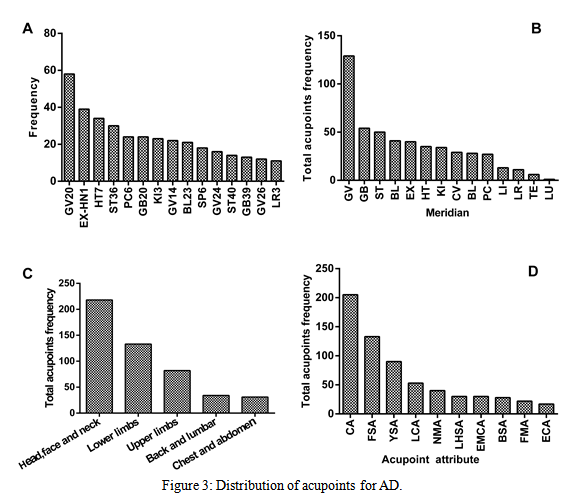
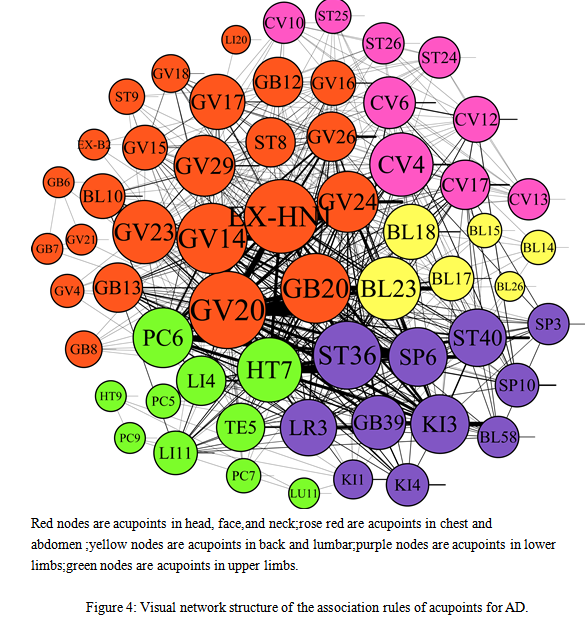
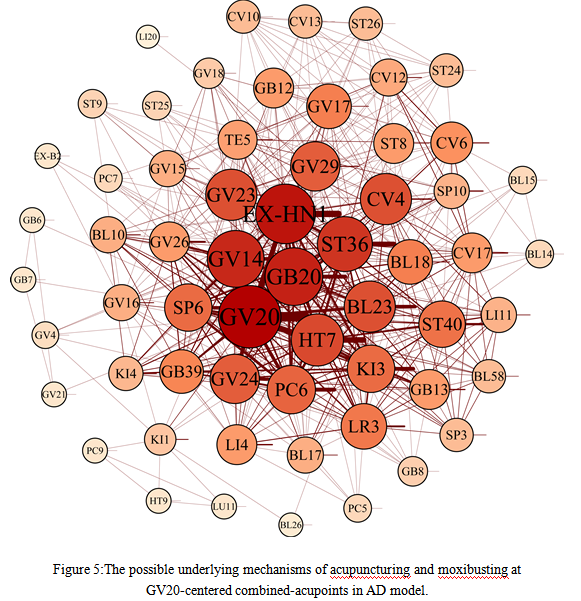

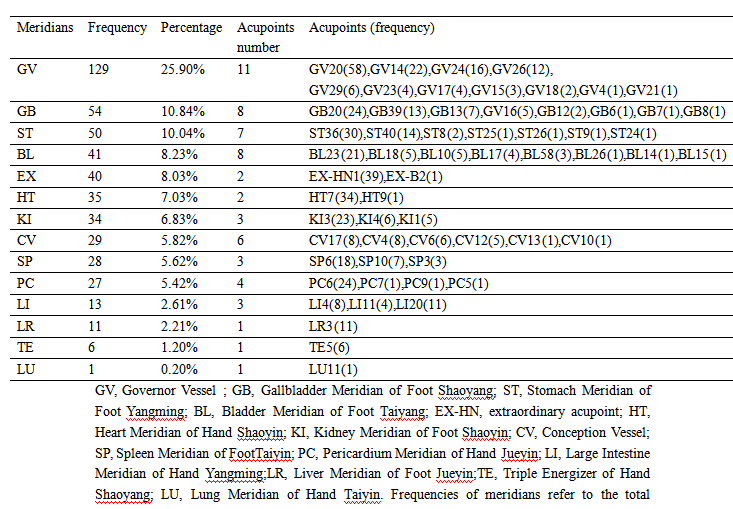
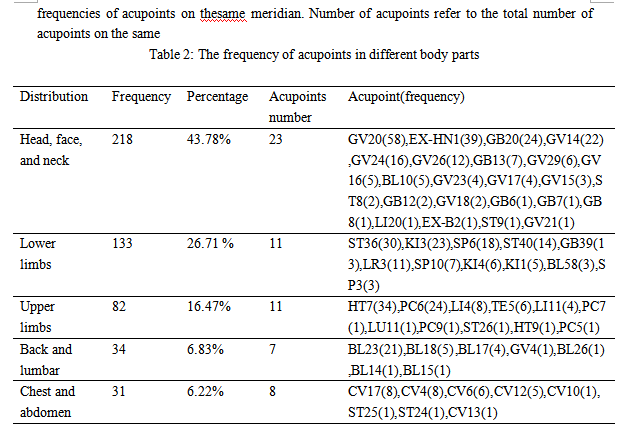


 World Federation of Acupuncture-Moxibustion Societies
World Federation of Acupuncture-Moxibustion Societies